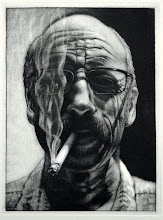A Brief History of Printmaking
Compiled by Highpoint Center for Printmaking
Printmaking has shaped culture in all parts of
the world. Originally used as a form of communication, printmaking is now
valued as an artistic medium with unique technical qualities. To make a print,
the artist typically creates an image on a surface made out of metal, stone,
wood, or other materials; the surface is then inked, and pressed onto paper to
create an original print. By repeating the printing process, the artist is able
to create multiple original works of art.
Printmaking has its roots in prehistoric times,
when humans placed their hands on cave walls and blew pulverized pigment around
them to create images. In approximately 500 BC, Sumerians carved images on
cylinder seals that could be pressed into wet clay, thereby creating multiple
imprints to indicate the ownership of goods. Chinese scholars created rubbings
from carved texts around 200 AD, an early form of printing that could be done
on paper and silk.
The invention of paper set the stage for
printmaking throughout the world, because paper was affordable and well-suited
to printing. As papermaking knowledge spread from China to the rest of Asia,
the Middle East, and Europe, printmaking became more widespread and
technologically sophisticated.
Printmaking initially flourished as a form of communication,
for it enabled artists to make multiples that could be disseminated to a large
number of people. Starting in the eighth century, Japanese artists used
printmaking to make multiple editions of Buddhist manuscripts. In fourteenth
century Europe, woodcut prints became a popular way to distribute Christian
images to the common people. In the fifteenth century, Gutenberg’s printed
Bible ushered in a whole new era of literacy.
From the Renaissance onward, individual artists
became known for their spectacular use of printmaking. Albrecht Dürer dazzled
fifteenth century audiences with the exquisite detail and consummate
craftsmanship of his paintings, woodblock prints, and engravings. Two centuries
later, Rembrandt’s mastery of the intaglio medium enabled him to create an
influential group of over three hundred printmaking plates. About the same
time, Japanese artists such as Katsushika Hokusai took the art of woodblock
printing to new heights. Over time, the “toolbox” of printmaking techniques
expanded to include etching, mezzotint, and eventually lithography, silkscreen,
and monoprint. As processes became more complex, more artists began to work in
printshops with professional facilities and the expertise of a Master Printer.
The late nineteenth century saw the rise of the
artist-printmaker in Europe and the United States. Whether working
independently or collaboratively with Master Printers, these artist-printmakers
helped to firmly establish their medium within the artistic canon. Seminal
figures within the nineteenth century include Turner, Whistler, Blake, Degas,
Cassatt, and Goya. Artist-printmakers in the first half of the twentieth
century include legends such as Chagall, Matisse, Munch, Picasso, Miro, Arp,
Ernst, Dali, Kollwitz, Beckmann, Barlach, Kandinsky, Klee, Hopper, and more.
In the same time period, artists all over the
world carried printmaking to new heights. Japanese artists, for example, worked
within the established tradition of ukiyo-e printmaking to create lumious
woodblock prints depicting scenes from mythology and everyday life. In Mexico,
artists such as José Posada flocked to printmaking for its graphic beauty and
potential to effect social change. The famous Mexican Taller de Gráfica Popular
(Workshop for Popular Graphics) provided access and inspiration for an entire
generation of artists.
Contemporary artists continue to use printmaking
for its unique visual qualities. As today’s artist-printmakers work with
time-honored hand processes, often in communal printmaking workshops that
foster collaboration and innovation, they build on the rich traditions of their
artistic forebears.





































